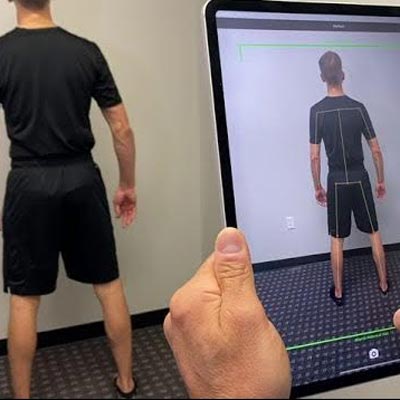Services
Scoliosis Care
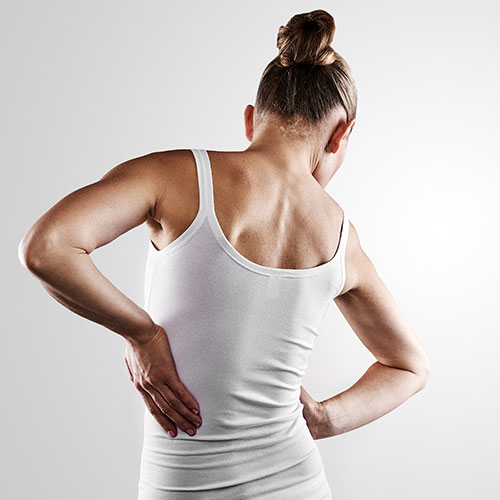 Scoliosis is a complex 3-Dimensional mechanical deformity of the spine and has been called the “orthopaedic enigma” due to its ambiguous aetiology (i.e., what causes it to happen?). Various mechanisms have been shown to be involved in its process however the only real strong scientific evidence at this stage is that commonly a genetic element is involved. The 3D deformity is a combination of the twisting, tilting and translating of the vertebrae which actually create the abnormal curve. A scoliosis can only be truly diagnosed by a weight bearing x-ray where the COBB ANGLE is measured in excess of 10 degrees and there is associated rotation (twisting) of the spinal vertebrae. It is estimated that 3% of the general population is affected by scoliosis and it is vital that early detection and management of this complex disorder occurs especially during the growth phases of early and teenage life.
Scoliosis is a complex 3-Dimensional mechanical deformity of the spine and has been called the “orthopaedic enigma” due to its ambiguous aetiology (i.e., what causes it to happen?). Various mechanisms have been shown to be involved in its process however the only real strong scientific evidence at this stage is that commonly a genetic element is involved. The 3D deformity is a combination of the twisting, tilting and translating of the vertebrae which actually create the abnormal curve. A scoliosis can only be truly diagnosed by a weight bearing x-ray where the COBB ANGLE is measured in excess of 10 degrees and there is associated rotation (twisting) of the spinal vertebrae. It is estimated that 3% of the general population is affected by scoliosis and it is vital that early detection and management of this complex disorder occurs especially during the growth phases of early and teenage life.
What are the Different Types of Scoliosis?
1. Congenital Scoliosis
This is basically when the individual is born with a bony abnormality such as a malformation of one of the spine’s vertebrae, e.g. hemi-vertebrae, which creates an asymmetry of the spine which can cause the spine to buckle and form a scoliosis.
2. Idiopathic Scoliosis
There are three types of Idiopathic Scoliosis (idiopathic means “of unknown cause”) which are each classified by the age in which the condition is actually diagnosed. It is the most common type of Scoliosis as 80% of scoliosis cases are idiopathic in origin and a scoliosis is usually assumed to be “classified as Idiopathic until the opposite is proven” (Zaina et al. 2012). However, it is important that the remaining 20% of cases are adequately assessed and managed due to the associated complications with these secondary Scoliosis.
– Infantile Onset Idiopathic Scoliosis is diagnosed between the ages of 0-3 and is more prevalent in males. It is the least common of the idiopathic scolioses and considered as one of the more difficult categories to manage due to the early stages of life and non-weight bearing capabilities of the young human frame. It is important to rule out any underlying disease processes in infantile cases and interestingly some cases, especially the lesser curves, do spontaneously resolve.
– Juvenile Onset Idiopathic Scoliosis (JIS) is diagnosed between the ages of 4-10. JIS generally has a high risk of scoliosis curve progression and approximately 70% of cases may require bracing if the curve advances beyond 25 degrees. Cases under the 25-degree threshold are monitored closely and usually exercises and spinal therapy are recommended initially.
– Adolescent Onset Idiopathic (AIS) Scoliosis is diagnosed between the ages of 10-16 and is more prevalent in females. This is the most common Scoliosis and is associated with puberty and the growth phase during teenage life.
3. Adult Scoliosis
There are two scenarios with an adult scoliosis which are:
Degenerative This is the progression of an idiopathic onset scoliosis which was undiagnosed or untreated and the progression of the curve has created degeneration of the spine.
De-Nova refers to a scoliotic curve that has been caused by “wear and tear” or degeneration of the spine. It is quickly becoming one of the most common presentations of Scoliosis.
According to Kebaish et al. (2011) the prevalence of Scoliosis increases with age, in so much that 9% of over 40-year olds and 30% of over 60-year olds respectively will develop a scoliotic spine; the primary concern in these presentations of adult cases is pain and disability.
Schwab et al. (2002) advocate that due to the altered mechanical loading conditions in adult scoliosis that there is an acceleration of the degenerative cascade which can augment conditions such as stenosis, spondylolisthesis and disc degeneration leading to a severe reduction in long term quality of life and independence.
4. Secondary Scoliosis
As the name suggests these are when a scoliosis occurs due to an underlying disease process. Common causes of the secondary scoliosis include Cerebral Palsy, Muscular Dystrophy, Ehlers-Danlos, Marfan’s Syndrome, Neurofibromatosis, Syringomyelia (Arnold Chiari), Osteoporosis and Hypermobility Syndrome.
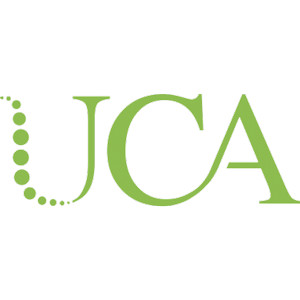
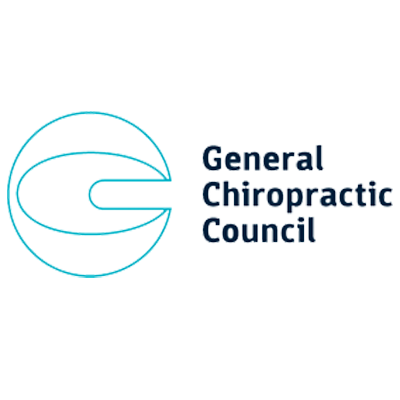
How Do We Assess A Suspected Scoliosis At Advanced Spinal Care?
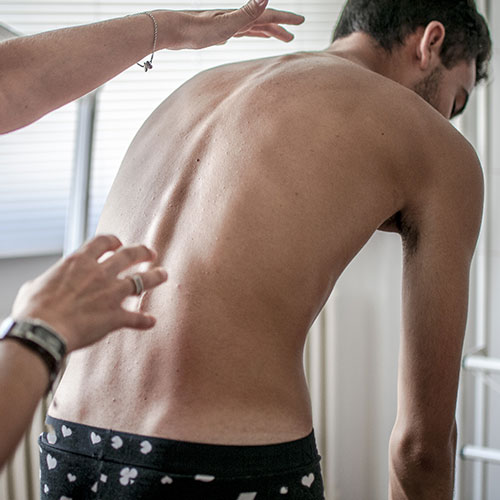 An initial consultation at Advanced Spinal Care includes a thorough history of the patient including family history, a thorough orthopaedic and neurological exam, specific Scoliosis postural and special tests including the use of a Scoliometer to ascertain any abnormal curvatures of the spine. A reading of 7 degrees or more on the Scoliometer (a type of protractor gauge) is suggestive of further investigation by x-ray. If weight bearing x-rays are indicated then we can perform these on-site with our digital x-ray equipment. If any abnormal exam and history findings suggest that an MRI is indicated then we can refer our patients to an independent source for a quick and efficient service for these in-depth images.
An initial consultation at Advanced Spinal Care includes a thorough history of the patient including family history, a thorough orthopaedic and neurological exam, specific Scoliosis postural and special tests including the use of a Scoliometer to ascertain any abnormal curvatures of the spine. A reading of 7 degrees or more on the Scoliometer (a type of protractor gauge) is suggestive of further investigation by x-ray. If weight bearing x-rays are indicated then we can perform these on-site with our digital x-ray equipment. If any abnormal exam and history findings suggest that an MRI is indicated then we can refer our patients to an independent source for a quick and efficient service for these in-depth images.
After reviewing all of the gathered information and data from the initial consultation we should be able to answer to the patient with a Report of Findings on whether they have a true scoliosis, the type of scoliosis, the size and location of the curve, the risk of progression of the curve and the recommended way forward in managing the condition.
According to Weinstein et al. (2013) only 0.3-0.5% of the population have progressive curves requiring treatment however the conundrum appears to be in the difficulty of determining which curves will progress? The prediction of the individual’s growth phase and the speed of growth seem to be key factors in the risk of progression and interestingly the growth phase is now considered the fourth dimension in correctional bracing treatment.

Conditions Treated
At Advanced Spinal Care at The Thames Clinic in Staines, UK, we have treated thousands of patients suffering from a wide range of health issues and conditions. We may be able to help you too.
Advanced Spinal Care
10B Goring’s Square,
Staines TW18 4EW,
United Kingdom
| Monday | 9 AM - 8 PM |
| Tuesday | 7 AM - 8 PM |
| Wednesday | 7 AM - 8 PM |
| Thursday | 7 AM - 8 PM |
| Friday | 7 AM - 12 PM |
| Saturday | Closed |
| Sunday | Closed |


